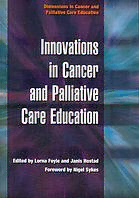
Innovations in cancer and palliative care education PDF
Preview Innovations in cancer and palliative care education
Innovations in Cancer and Palliative Care Education Edited by Lorna Foyle Lecturer,CancerandPalliativeCare UniversityofLeeds and Janis Hostad Lecturer/EducationandDevelopmentCoordinator HullandEastYorkshireHospitalsTrust Foreword by Nigel Sykes MedicalDirector StChristopher’sHospice,London Radcliffe Publishing Oxford (cid:1)New York RadcliffePublishingLtd 18MarchamRoad Abingdon OxonOX141AA UnitedKingdom www.radcliffe-oxford.com Electroniccatalogueandworldwideonlineorderingfacility. _____________________________________ #2007LornaFoyleandJanisHostad TheauthorshaveassertedtheirrightundertheCopyright,DesignsandPatentsAct1998 tobeidentifiedasauthorsofthiswork. Allrightsreserved.Nopartofthispublicationmaybereproduced,storedinaretrieval systemortransmitted,inanyformorbyanymeans,electronic,mechanical, photocopying,recordingorotherwise,withoutthepriorpermissionofthecopyright owner. BritishLibraryCataloguinginPublicationData AcataloguerecordforthisbookisavailablefromtheBritishLibrary. ISBN-13:9781846190568 TypesetbyAdvanceTypesettingLtd,Oxford PrintedandboundbyTJIDigital,Padstow,Cornwall Contents Foreword v Preface vii Abouttheeditors ix Listofcontributors x Acknowledgements xii 1 High-fidelityclinicalsimulationincancerandpalliativecareeducation 1 NeilPease 2 Theuseofcompetenciesinpalliativecareeducation 13 RobertBecker 3 Problem-basedlearning:notsuchaproblem 24 JeanFisher 4 Theconundrumsofdeliveringchemotherapycare:tacklingthe educationalchallenges 37 KrystinaKoslowska 5 Leadingtheway:theroleofeducationinachievingclinicalstandards inthehaematologicaloncologysetting 48 KirstenMidgley 6 Approachestomulti-professionalradiotherapyeducation 62 KathrynGuyers 7 Takingthepainoutofpainmanagementteaching 70 SharonWood 8 Teachingsymptommanagement 85 SarahCallinandFionaHicks 9 Teachingethicsincancerandpalliativecare 96 JanetHolt 10 Informationforserviceusers:educationalimplications 107 Sally-AnnSpencerGrey 11 Pre-registrationnursing:cancerandpalliativecareeducation 125 JulieMacDonaldandTraceyMcCready 12 Isnurseeducationinpaediatricandadolescentoncologyfitfor purpose? 136 SueFallonandLindaSanderson 13 Educationalstrategiestoimprovepalliativecareforlearning-disabled patients 148 JackieSaunders iv Contents 14 Palliativecareinnursinghomes:aneducationalchallenge 160 PatriciaHirstandAnneBoyce 15 Familycare:sensitiveanddynamicapproachestoteaching 169 PamFirth 16 Mappingthelandscape:spiritualityincancerandpalliativecare education 185 ElizabethFoster 17 ‘Let’stalkaboutit–weneverdo.’Sexualhealthincancerand palliativecare:aneducationaldilemma? 197 JanisHostad 18 Complementarytherapies:progressingfromknowledgetowisdom 220 RuthSewell 19 Rehabilitation:imperativesincancerandpalliativecareeducation 236 KimPlatt-Johnson 20 Teachingapproachestosurvivorshipissuesincancercare 251 CandyCooley 21 Healthandsocialpolicyeducation:universallyrelevant,studiously avoided 260 LornaFoyle Index 274 Foreword ThisisthesecondbookintheseriesDimensionsinCancerandPalliativeCareEducation. Thefirstbookhavingplacedcancerandpalliativecareeducationinitshealthcare context,itisnowtimetolookatsomeinnovationsinthisfield. Palliativecareisaspecialtywhosetimehascome.TheNHSCancerPlanpublished in2000hadpalliativecareatitsheart(ornottoofarfromit,anyway)andin2004 palliative care was dignified by its own guidance document from the National InstituteforClinicalExcellence.Inaddition,although‘palliativecare’and‘cancer’ remain closely linked in the minds of many, the UK government imperative to make palliative care available to all who need it, regardless of disease label, has gatheredpace.HavingbegunwiththeSNMAC/SMACreportof1992thisdrivehas most recently found expression in a series of National Service Frameworks that have called for palliative care to be available to people with disorders such as neurodegenerativediseaseorheartfailure.OutsidetheUKtheWHOnowregards palliative care as a fundamental component of Cancer Control Programmes, and therearesignsthatatlastthepressingneedforpalliativecaretohaveasimilarstatus in HIV/AIDS programmes in sub-Saharan Africa and elsewhere is starting to be recognisedbytheagenciesconcerned. British palliative care is unique among UK healthcare specialties in being provided to a considerable extent by providers outside the NHS. However, these voluntaryprovidersforthemostpartreceiveasignificantelementoftheirfunding fromtheNHSandsoarenotexemptfromnationalpriorities.Thismeansthatthey also must answer to the agendas of equity and choice, as exemplified by the wideningofaccesstopalliativecareforpeoplewithnon-malignantconditionsand tovulnerableandunder-servedgroups. Asaresulttherehasneverbeenaperiodwheneducationinpalliativecareissues has been more topical or in demand, and some of the areas mentioned will be coveredinthethirdbookinthisseries(duetobepublishedin2008).Meanwhile, the present book gives us a three-dimensional view of how to respond to the demandsoncancerandpalliativecareeducationtoday,setparticularlyinaBritish context but, of course, capable of extrapolation to other settings. These three dimensionsofinnovationcanbesummarisedas:Whatdoyouteach?Howdoyou teachit?Towhomdoyouteachit?Innovationinallthreeaspectssimultaneously maybedifficulttoachieve,butallwhohavearesponsibilityforeducationarefaced with the challenges of making their teaching more effective (and demonstrating that they have done so), keeping abreast of advancing knowledge and clinical practice,andofreachingouttogroupsoflearnerswhohithertohavebeenneglected. Therefore this book contains chapters that might refresh those who teach a subjectarearegularly,andothersthatmighthelpeducatorsembarkonhandlinga topic new to their teaching repertoire. On one hand the staples of cancer and palliative care teaching, such as pain and symptom control, chemotherapy and radiotherapy are covered, but with an aim of helping the reader freshen and reinvigoratetheirapproachtothematerial.Ontheotherhandtherearedescrip- tionsofhowtotacklelesswell-troddentopicssuchassexuality,publiccommuni- cation and survivorship that both raise the profile of these important but vi Foreword overlooked subjects and provide encouraging pointers as to how to embark on helpingotherstolearnaboutthem. As well as neglected subjects there are also considerations of how to reach neglected student groups such as nursing home staff and carers of people with learning disabilities. The increasing proportion of nursing home residents recog- nisedtohavepalliativecareneeds,togetherwiththeunder-accessofpeoplewith learning difficulties to palliative care services, mean that these are vital pieces of educationaloutreach. Throughoutallthisrunstheneedtoassesstheeffectivenessofourteachingand the quality of the staff who participate in it. Both aspects of this requirement to assessaremetbytheuseofcompetencies–whatcompetenciesdoindividualshave, and how have these been enhanced by the education in which they have par- ticipated?Inattemptingtogiveamultifacetedaccountofcancerandpalliativecare teachingasitis(orshouldbe)today,thisbookalsoincludesaconsiderationofthe issues surrounding the use of competencies as a method of education outcome assessment. Thepressureforaccountabilityinallkindsofserviceprovisionimplies,among other things, an increasing professionalisation of healthcare education. Nursing andtheAlliedHealthProfessionshaveledthewayandtoalargeextentitisfrom thisbackgroundthatthisbookanditsforerunnerhaveemerged.Withtheforma- tionoftheAcademyofMedicalEducators,doctorsarecatchingup.Buttheywill havetobattlewiththeconundrumofhowtobalancetheconcentrationontherole ofeducatorwiththemaintenanceoftheroleofclinicianthatalonecangiveclinical teachinglifeandcredibility.Thisbookwillnotsolvethatdilemmabutitwillbeof significanthelptoanyoneinthisfieldwhoseconcernisthedeliveryofeffectiveand appropriateeducation. DrNigelSykes MedicalDirector StChristopher’sHospice,London March2007 Preface Thenatureofeducationismulti-dimensional–hencetheseriestitle,Dimensionsin CancerandPalliativeCareEducation.Thefirstbookinthisseries,entitledDelivering CancerandPalliativeCareEducation,lookedatcontextualisingtheroleandrelevance ofcancerandpalliativecareeducationincurrenthealthcareprovisioninatwenty- first-centurycultureoftechnologicaladvancement.Inherentwithinthisclimateof scientificchange,patientsandhealthcareprofessionalsalikeareseekingtoconnect and communicate at a deeper level when encountering each other during the healthcare experience of both patient and carer. Cancer and palliative care diag- nosesoftenproducechallengingandrhetoricalquestionsforpatientsandlaycarers as they struggle to achieve a more meaningful understanding of the nature of illness,lifeandexistenceitself.Clinicianstodayareprobablychallengedmoreby theesotericcomponentsofcaredeliverythanbythemorepracticalandscientific elements. Both of these types of care are necessary, and a careful blend of these abilitiesisessentialtoensurethatahighstandardofqualitycareisdeliveredand experienced.Theeducationofclinicianstoachievethesehighstandardsisexacting andoftenrequiressomeinnovativeapproaches.Withthisinmind,wesoughtout those educators whom we had heard at conferences or who had been recom- mendedtousbecauseoftheirknowledgebaseandtheircommandoftheirtopic area. Invitations were issued, and the quantity and quality of the responses far exceededtherequirementsforonebook.Thereforetherewillbeanothervolumein this series, which will cover aspects not addressed within this book (due to be publishedin2008).Thereaderwillnotbedisappointedbythecontributionstothe present book. Not only have the contributors shared their extensive knowledge base, but they have also divulged some very practical and original methods of teachingtheirtopics. Asthechaptersforthisbookwerereceived,thetitleofthebook–Innovationsin CancerandPalliativeCareEducation–becameapparentwithoutmuchdeliberationas thecompositionandcontentofthechaptersillustratedjusthowimaginativeand innovative our contributors were in their educational role. Prepare to be as informed,intriguedandinspiredaswewerewhilsteditingthebook. Thisserieswasinitiatedinordertoassistfull-timeeducationalistsincancerand palliative care by extending their skills and knowledge in the delivery of these topics. Similarly, clinicians who have an educational responsibility and who are exploringdifferentaspectsofsubject-specifictopicsandteachingmethodswillfind awealthofusefulandpracticalinformationinthisbook.Educationalistsinother fields of healthcare provision will also glean knowledge about different teaching stylesandtechniqueswiththepossibilityofenhancingtheirskills. The authors’ contributions provide the reader with a valuable resource with whichtodeveloptheirknowledgeofspecificcurrentthemesincancerandpalli- ativecareprovision,whileatthesametimeprovidingthemwithadiverserangeof educationalstrategies. Mostofthechaptershavebeenarrangedinaspecificordersoastomaximisethe learningexperience.Inafewchaptersthisformathasnotbeenadheredto,inorder toaccommodatethenuancesandfinerpointsofaparticulartopic.Thequotesatthe viii Preface beginningofeachchapterhavebeenselectedbytheauthorseithertosummarise thecontentsofthechapterortostimulatethereader’sthinkingaboutthepotential of the chapter. Each chapter includes an aim and learning outcomes in true educational tradition to guide the reader in achieving the appropriate learning fromthechapter.Theintroductionandbodyofeachchapterareintendedtoimpart theinformationnecessarytoenablethereadertoachievethelearningoutcomes. Attheendofeachchapter,inadditiontotheconclusion,keypointssummarise thepertinentissuesandconcernsthathavebeenraisedinthechapter,andalistof implicationsforthereader’sownpracticeraisesquestionstochallengethereader’s thinking and assist them in applying key concepts to clinical practice. Where appropriate, lists of further reading and useful resources have been supplied in ordertoassistthereaderintheirprofessionaldevelopment. This book has sought to demystify some of the educational processes, and it provides akaleidoscope of teaching andlearningtheoriesandtechniques forthe subjects of cancer and palliative care. Some educational tools are provided for applying the theoretical aspects of palliative care and cancer education to the clinical care of those affected by a diagnosis of cancer and/or palliative care. It is hoped that this book not only inspires creative teaching but also, through this education,motivatesclinicianstodelivertotalqualitycareinasmanyeffectiveand innovativewaysaspossible. Ifyouhavebuiltcastlesintheair,yourworkneednotbelost;thatiswherethey shouldbe.Nowputthefoundationsunderthem. HenryDavidThoreau(1817–1862) LornaFoyle JanisHostad March2007 About the editors Lorna Foyle MSc,BAHons,CertEd,DipHEPallCare,NDNCert,RGNCertinCounselling,NLP Practitioner Lecturer,CancerandPalliativeCare,UniversityofLeeds JanisHostadMSc,BAHons,CertEd,DipHEPallCare,NDNCert,RGNDiplomainCounselling,NLP Practitioner Lecturer/EducationandDevelopmentCoordinator,HullandEastYorkshireHospitalsTrust. The two editors’ combined experience in cancer and palliative care adds up to 40years.Theearlypartoftheirexperiencewasfirmlyrootedintheclinicalsetting whileinlatteryearstheirfocushasswitchedtoeducationandresearch.
